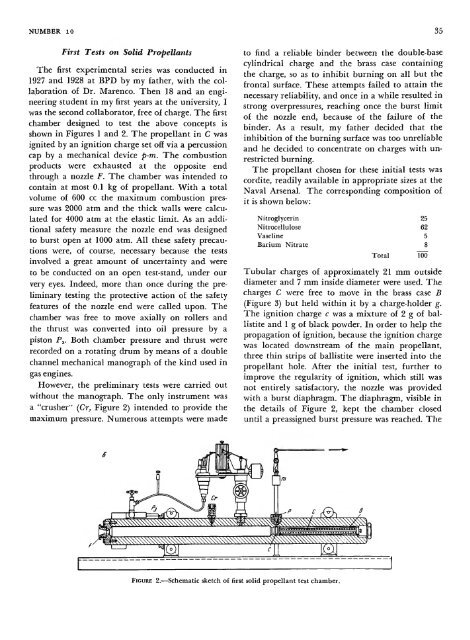FIRST STEPS TOWARD SPACE - Smithsonian Institution Libraries
FIRST STEPS TOWARD SPACE - Smithsonian Institution Libraries
FIRST STEPS TOWARD SPACE - Smithsonian Institution Libraries
Create successful ePaper yourself
Turn your PDF publications into a flip-book with our unique Google optimized e-Paper software.
NUMBER 10 35<br />
First Tests on Solid Propellants<br />
The first experimental series was conducted in<br />
1927 and 1928 at BPD by my father, with the collaboration<br />
of Dr. Marenco. Then 18 and an engineering<br />
student in my first years at the university, I<br />
was the second collaborator, free of charge. The first<br />
chamber designed to test the above concepts is<br />
shown in Figures 1 and 2. The propellant in C was<br />
ignited by an ignition charge set off via a percussion<br />
cap by a mechanical device p-m. The combustion<br />
products were exhausted at the opposite end<br />
through a nozzle F. The chamber was intended to<br />
contain at most 0.1 kg of propellant. With a total<br />
volume of 600 cc the maximum combustion pressure<br />
was 2000 atm and the thick walls were calculated<br />
for 4000 atm at the elastic limit. As an additional<br />
safety measure the nozzle end was designed<br />
to burst open at 1000 atm. All these safety precautions<br />
were, of course, necessary because the tests<br />
involved a great amount of uncertainty and were<br />
to be conducted on an open test-stand, under our<br />
very eyes. Indeed, more than once during the preliminary<br />
testing the protective action of the safety<br />
features of the nozzle end were called upon. The<br />
chamber was free to move axially on rollers and<br />
the thrust was converted into oil pressure by a<br />
piston P3. Both chamber pressure and thrust were<br />
recorded on a rotating drum by means of a double<br />
channel mechanical manograph of the kind used in<br />
gas engines.<br />
However, the preliminary tests were carried out<br />
without the manograph. The only instrument was<br />
a "crusher" (Cr, Figure 2) intended to provide the<br />
maximum pressure. Numerous attempts were made<br />
to find a reliable binder between the double-base<br />
cylindrical charge and the brass case containing<br />
the charge, so as to inhibit burning on all but the<br />
frontal surface. These attempts failed to attain the<br />
necessary reliability, and once in a while resulted in<br />
strong overpressures, reaching once the burst limit<br />
of the nozzle end, because of the failure of the<br />
binder. As a result, my father decided that the<br />
inhibition of the burning surface was too unreliable<br />
and he decided to concentrate on charges with unrestricted<br />
burning.<br />
The propellant chosen for these initial tests was<br />
cordite, readily available in appropriate sizes at the<br />
Naval Arsenal. The corresponding composition of<br />
it is shown below:<br />
Nitroglycerin<br />
Nitrocellulose<br />
Vaseline<br />
Barium Nitrate<br />
FIGURE 2.—Schematic sketch of first solid propellant test chamber.<br />
Total<br />
25<br />
62<br />
5<br />
8<br />
Too<br />
Tubular charges of approximately 21 mm outside<br />
diameter and 7 mm inside diameter were used. The<br />
charges C were free to move in the brass case B<br />
(Figure 3) but held within it by a charge-holder g.<br />
The ignition charge c was a mixture of 2 g of ballistite<br />
and 1 g of black powder. In order to help the<br />
propagation of ignition, because the ignition charge<br />
was located downstream of the main propellant,<br />
three thin strips of ballistite were inserted into the<br />
propellant hole. After the initial test, further to<br />
improve the regularity of ignition, which still was<br />
not entirely satisfactory, the nozzle was provided<br />
with a burst diaphragm. The diaphragm, visible in<br />
the details of Figure 2, kept the chamber closed<br />
until a preassigned burst pressure was reached. The

















